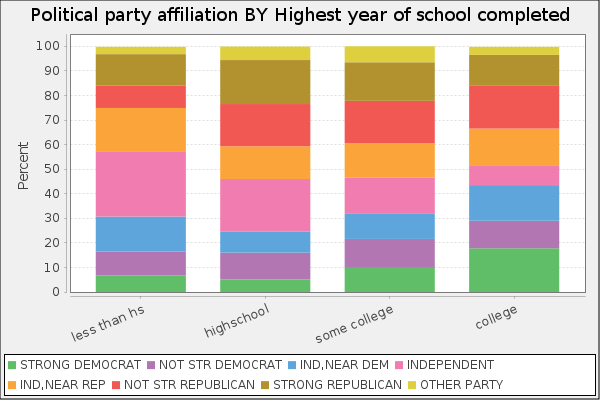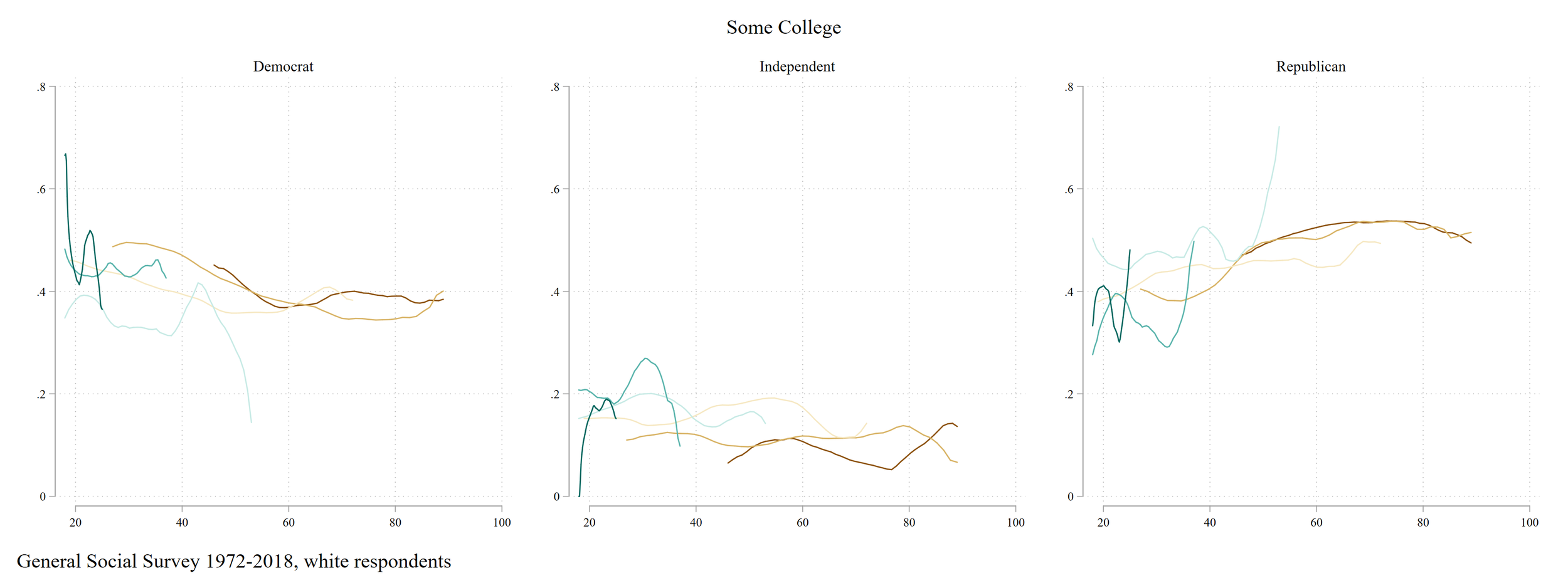David Schor, political analyst now famous for presumably being fired for tweeting a research article at an inopportune time, recently highlighted the fact that the Democratic party is increasingly concentrated among those with a college degree or more. He focuses on white individuals, presumably because of the troubled history of the Republican party rallying against, and thus recruiting, racial and ethnic minorities, particularly black individuals.
https://twitter.com/davidshor/status/1387134153775321096
Yup. It’s easy to see a transition over time. I was curious about the cohort dynamics. Is this basically a cohort replacement situation, or are folks changing their minds as they age?
I used General Social Survey data between 1972 and 2018. First, let’s look at the change in educational attainment over time.
Unsurprisingly, we see educational attainment grow over time. WAY fewer people have less than a high school degree, the percent of folks with an advanced degree has doubled, from about 5% to about 10%, as has the percent of folks with a college degree, from about 10% to about 20%.
So how has political party identification changed in this sample over time?
I’m no expert in politics, but this looks about right to me: the rise of the Republicans in the 1980s, the decline of the Democrats through the 2000s, and the moderate rise of the independents in recent years.
Now, changes over time that motivated the Shorr tweets can hold a lot of heterogeneity. I’m curious about intercohort changes in the patterns noticed. Are we seeing substantial realignments within cohorts, or between them? I separated the GSS samples into six rough birth cohorts: (1901/1926 "Greatest Generation") (1927/1945 "Silent Generation") (1946/1964 "Baby Boomers") (1965/1980 "Gen X") (1980/1989 "Millenial") (1990/2000 "Gen Z"). Then, I tracked education / party identification in these cohorts across age.
First, let’s look at the party affiliation across cohorts and age among those with just a college degree.
Massive intergenerational change. At roughly early middle age, 30ish-40ish, the Greatest Generation was 30% Democrat. Among millennials, it’s 60%. Two other points: [1] I see a simple transition from Republican to Democrat. Not a lot of interesting action going on among Independents. [2] The only cohort with much within-cohort change is the Silent Generation, whose Democratic affiliation plummeted between their 30s and 80s. Boomers, X’ers, and to a lesser extent, Millenials are more stable.
What about folks with just a high school degree? I’ll use the same color scheme.
Huh…this isn’t what I expected. I assumed that High School would shift towards Republicans. Instead, it looks like Democratic dominance hemorrhaged to Independents. This is reminiscent of the lack of institutional incorporation working class and lower educated folks are facing these days.
Let’s move onto those surrounding High School, “Less than High School” and “Some College.”
Hmm…not a lot of action among “Some College.” I thought this group would have sharp changes over time due to feelings of being spurned and indebted. But I guess not! For “Less than High School,” we again see an exodus from the Democratic party, but into Independent identification.
Ok, finally Advanced Degrees. No Gen Z, because they’re too young!
WEIRD! Where’s the massive Democrat-ification!? It’s just not there, except for some weird and certainly idiosyncratic noise at the tail end of the Millenials. Advanced degree holders are pretty consistently 55/40 Democrat/Republican. So the massive transition to the Democrats is from the lower educated to the higher, but not highest, educated. At least for now.
Without much knowledge about political parties, it seems like Democrats hitched their wagons to the right rising demographic group. Folks with a college degree are growing in numbers, especially among younger cohorts. I’m confused about what’s going on with Independents and Republicans. Is “Independent” just code for Republican? I do worry about education polarization, as Democrats, who presumably are the party who provides economic protection for the less economically well off, are not connected to the least economically well off, at least proxied by education levels. And sadly, the jettisoning of institutional affiliation among those with less education mirrors the broader exodus of institutional affiliation and protection among folks on the lower end of the socioeconomic distribution. What I’m really curious about is how these trends compare to those found among Black individuals. I assume that Black folks in the GSS start with a higher rate of Democratic affiliation, but are the intercohort trends similar? That’s my next post!








